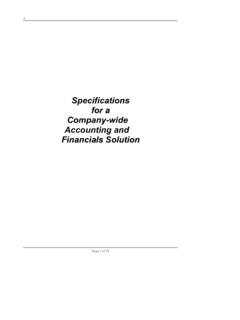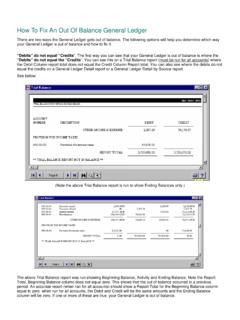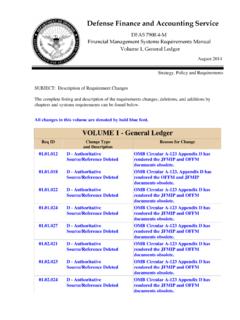Transcription of ACCOUNTING MANUAL ON DOUBLE ENTRY …
1 1 ACCOUNTING MANUAL ON DOUBLE ENTRY SYSTEM OF ACCOUNTING FOR ICFRE 2 CONTENTS A) Bookkeeping 1) About Single ENTRY System and its disadvantages 2) About Bookkeeping and ACCOUNTING Process 3) About DOUBLE ACCOUNTING System and its advantages. 4) Classification of Accounts 5) Golden Rule of Debit and Credit 6) Abbreviations used in Accounts 7) Understanding Debits and Credits 8) Understanding Cash Book, Journal, general ledger , Trial Balance, Income & Expenditure Account and Balance Sheet. 9) DOUBLE ENTRY Working Examples 10) Notes and References B) Main MANUAL 1) Books/ Documents to be maintained 2) Procedures to be followed to Convert the Single ENTRY System to DOUBLE ENTRY System 3) Notes and Suggestions 4) Performa of Debit/Credit note 5) Illustration for working 3 1. Single ENTRY ACCOUNTING System Single ENTRY system of book keeping may be described as a loose and defective way of recording transactions, wherein some transactions are recorded in their two fold aspect, some are recorded in so far as they effect one aspect only, and few other are completely omitted to be recorded.
2 Thus it can be seen that there is no system or method about single ENTRY . Under this system a cash book and other ledger are maintained. Disadvantages of Single ENTRY System. Since every debit does not have a corresponding credit, a Trial Balance can not be extracted to test the arithmetical accuracy of the entries. In absence of proper records of any assets and of any allowances for depreciation or other losses of value, it is not possible to prepare a Balance Sheet. It is too easy to perpetrate the errors and frauds and too difficult to detect them. 2. The book Keeping and ACCOUNTING Process In accountancy the DOUBLE ENTRY Bookkeeping (or DOUBLE ENTRY ACCOUNTING ) is the basis of the standard system used by businesses and other organizations to record financial transactions. The system is called DOUBLE ENTRY because each transaction is recorded in at least two accounts.
3 Each transaction results in at least one account being debited and at least one account being credited with the total debits of the transaction equal to the total credits. For example: - If Company A sell an item to Company B and Company B pay Company A by cheque then the book keeper of Company A credits the Sales and debits the Bank . Conversely the bookkeeper of Company B debits the account Purchases and credits the account Bank . 4 Historically the debit entries are recorded on the left side and credit values on the right hand side of the general ledger account and in the normal course of business, a document is produced each time a transaction occurs. Sales and purchases usually have invoices or receipts. Deposit slips are produced when lodgements (deposits) are made to a bank account. Bookkeeping involves recording the details of all of these source documents into multi-column journals (also known as a book of first ENTRY or daybooks.)
4 After a certain period typically a month, the columns in each journal are totaled to give a summary for the period. Using the rules of DOUBLE ENTRY , these journal summaries are then transferred to their respective accounts in the ledger is called Posting. Once the posting process is complete, accounts kept using the T format undergo balancing which is simply a process to arrive at the balance of the account. 3. DOUBLE ENTRY ACCOUNTING system The system of DOUBLE ENTRY may be well compared to a scale which must have equal weight on both sides in order that the scale is balanced. Thus if the weight of one side of the scale is increased or decreased the same weight must be correspondingly added to or removed from, the other side. A more common expression of DOUBLE ENTRY book keeping system is the ACCOUNTING equation. The total assets of a firm/ institution are equal of the equities.
5 This reflects the fundamental equation of A= E, Where A denotes Assets and E denotes equity. Assets are the goods and properties which the institute owns as well as claims against outsiders which the institute has not yet collected. 5 Equities are the claims against the assets and indicate the source of assets. The source may be owners themselves or outsiders, owners invest funds in Organization and Creditors lend money in the Organization. Advantage of DOUBLE ENTRY System:- It is possible to keep a full record of dual aspect of each transaction. Transactions are recorded in a scientific and systematic manner and thus the books of accounts provide the most reliable information for controlling the Organization efficiently and effectively. Since the total debit under this system be equal to total Credit, arithmetical accuracy of the books can be tested by means of a trial balance.
6 An income and expenditure accounts can be prepared to know the excess income/ expenditure during a particular period and to know how such excess income/ expenditure has arisen The financial position of the Organization can be readily ascertained by preparing a Balance Sheet. Frauds are prevented, because alteration in accounts becomes difficult and discovery of irregularities is facilitated. 4. Classification of Accounts:- Personal Account:- when a transaction involved with a person known as personal account such as Mr. Roy, Bose& sons ABC Ltd. co. etc. Nominal Account:- All recurring expenses/incomes are known as Nominal Account, such as salary, Rent, Interest etc. Real Account:- Other than above two accounts all are fall under this category, such as Machinery, Furniture etc. 6 5. Golden Rule of Debit and Credit In case of Personal Account - Debit the receiver and Credit the giver. In case of Nominal Account- Debit all expenses and losses and Credit all income and liabilities.
7 In case of Real Accounts - Debit what comes in and credit what goes out. 6. Abbreviations used in bookkeeping - a/c account B/S Balance Sheet c/d carried down b/d brought down b/f brought forward Dr Debit record Cr Credit record G/L general ledger : (or N/L Nominal ledger ) P&L Profit & Loss TB Trial Balance 7. Understanding Debits and Credits - In a simpler way it can be explained as when an amount is entered on the left side of an account, it is a debit and the account is said to be debited. When an account is entered on the right side, it is a credit, and the account is said to be credited. Here are basic debit & credit rule: - 7 Assets & Expenses _____ Dr Cr (Increases) (Decreases) Liabilities, Capital and Income _____ Dr Cr (Decreases) (Increases) An account has a debit balance when the sum of its debits exceeds the sum of its credits: it has a credit balance when the sum of the credits is the greater.
8 In DOUBLE - ENTRY ACCOUNTING , which is in almost universal use, there are equal debit and credit entries for every transaction. Where only two accounts are affected, the debit and credit amounts are equal. If more than two accounts are affected, the total of the debit entries must equal the total of the credit entries. Debits and Credits DOUBLE - ENTRY bookkeeping is governed by the ACCOUNTING equation. If revenue equals expenses, the following basic equation must be true: Assets = liabilities + equity 8 At any point in time, revenue may not equal expenses. If so the equation can be further expanded, so that the (extended) equation becomes: Assets = liabilities + equity + (revenue expenses) Examples of debits and credits Purchase of a Computer Debit Computer account (Fixed asset account) is increased Credit Creditors account (Liability account) is increased Paying supplier for the Computer Debit Creditors account (Liability account) is reduced.
9 Credit Bank account (Asset account) is reduced. 8. Understanding Cash Book, Journal, general ledger , Trial Balance, Income & Expenditure A/c and Balance Sheet: - Cash Book - All cash transactions are entered in the cash book straightway, and ledger accounts are prepared on the basis of such records. Hence, Cash Book is considered as a Subsidiary book. Cash book is again a ledger and a principal book since, it serves as cash account and book account, the balances of which are recorded in the trial balance via ledger directly. Cash book has debit and credit sides. All receipts are entered on the debit side and all payments are entered on the credit side. It is maintained under the DOUBLE ENTRY principle. Feature of Cash Book: 1. All cash receipts and cash payments are entered chronologically in the cash book 9 2. It never shows a credit balance 3. It serves the functions of Journal also.
10 Journal A journal is a record that keeps ACCOUNTING transactions in chronological order as they occur. All ACCOUNTING transactions are recorded through journal entries that show account names, amounts, and whether those accounts are recorded in debit or credit side of accounts. A journal ENTRY is called "balanced" when the sum of debit side amounts equals to the sum of credit side amounts. general ledger The complete set of accounts for a business ENTRY is called a general ledger . It is the reference book of the ACCOUNTING system and is used to classify and summarize transactions and to prepare data for financial statements. It is also a valuable source of information for managerial purposes, giving for example the amount of sales for the period or the cash balance at the end of the period. Trial Balance As every transaction results in an equal amount of debits and credits in the ledger , the total of all debit entries in the ledger should equal the total of all credit entries.



